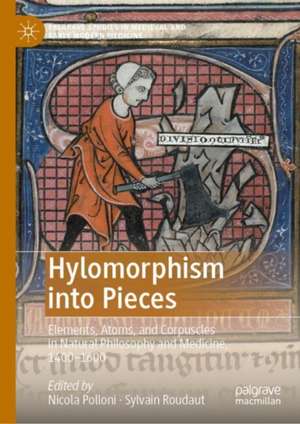Hylomorphism into Pieces: Elements, Atoms, and Corpuscles in Natural Philosophy and Medicine, 1400–1600: Palgrave Studies in Medieval and Early Modern Medicine
Editat de Nicola Polloni, Sylvain Roudauten Limba Engleză Hardback – 11 sep 2024
the Middle Ages to the Modern Era, this book is essential reading for scholars of philosophy, and historians of medieval and early modern science and medicine.
Preț: 842.06 lei
Preț vechi: 1026.90 lei
-18% Nou
Puncte Express: 1263
Preț estimativ în valută:
161.13€ • 172.30$ • 134.35£
161.13€ • 172.30$ • 134.35£
Carte tipărită la comandă
Livrare economică 17 aprilie-01 mai
Preluare comenzi: 021 569.72.76
Specificații
ISBN-13: 9783031609268
ISBN-10: 3031609263
Pagini: 400
Ilustrații: Approx. 400 p. 4 illus.
Dimensiuni: 148 x 210 mm
Greutate: 0.6 kg
Ediția:2024
Editura: Springer International Publishing
Colecția Palgrave Macmillan
Seria Palgrave Studies in Medieval and Early Modern Medicine
Locul publicării:Cham, Switzerland
ISBN-10: 3031609263
Pagini: 400
Ilustrații: Approx. 400 p. 4 illus.
Dimensiuni: 148 x 210 mm
Greutate: 0.6 kg
Ediția:2024
Editura: Springer International Publishing
Colecția Palgrave Macmillan
Seria Palgrave Studies in Medieval and Early Modern Medicine
Locul publicării:Cham, Switzerland
Cuprins
Chapter 1:Nicola Polloni and Sylvain Roudaut- Hylomorphism into Pieces? Introductory Remarks.- Chapter 2: Aurélien Robert- Atoms, Minima and Points: Democritean Corpuscularism in the 13th Century.- Chapter 3: Roberto Zambiasi - The ‘No-Frills’ Doctrine of Minima naturalia in the Latin Middle Ages and in the Renaissance: A First Exploration.- Chapter 4: Henrik Lagerlund - The Changing View of Successive Entities in the 14th Century: Peter of Mantua on Matter and Form.- Chapter 5: Claire Murphy - Unity out of Multiplicity: Nicholas of Cusa’s Theory of the Elements.- Chapter 6: Luca Burzelli - Pietro Pomponazzi and the Debate on the Four Elements.- Chapter 7: Sylvain Roudaut - Points of Form and Other Minima: Hylomorphism and Indivisibles in the Circle of John Mair.- Chapter 8: Russell Friedman - Late Scholastic Thomism into Pieces: Hylomorphism and Indeterminate Dimensions in Domingo Báñez’s Commentary on De generatione et corruptione.- Chapter 9: Nicola Polloni - Francisco de Toledo on Elemental Mixtures.- Chapter 10: Fabrizio Bigotti - Prime Matter is Three-Dimensionality: The Debate on the Extension of Prime Matter from Zabarella to Galileo.- Chapter 11:Hiro Hirai- Jacob Schegk, Simplicius and “Anaxagoras the Atomist”: Aristotelian Commentaries and Renaissance Corpuscularism.- Chapter 12:Erik Åkerlund - Rodrigo de Arriaga’s Substance Trialism.
Notă biografică
Nicola Polloni is an Associate Professor of Medieval Philosophy at the University of Messina, in Italy. His research delves into medieval hylomorphism, focusing on the tensions arising from the intertwining of metaphysics and natural philosophy.
Sylvain Roudaut is a Research Fellow at KU Leuven in Belgium. His research focuses on the interaction between metaphysics, natural philosophy, and mathematics in the Middle Ages.
Sylvain Roudaut is a Research Fellow at KU Leuven in Belgium. His research focuses on the interaction between metaphysics, natural philosophy, and mathematics in the Middle Ages.
Textul de pe ultima copertă
Focussing on late medieval and early modern philosophy and medicine, this edited collection explores the replacement of hylomorphism—the dominant theory of bodies in the Middle Ages—with new theories of matter such as corpuscularianism and atomism at the dawn of the Modern period. Together, the contributions offer a comprehensive overview of a crucial historical moment for the history of philosophy and science: the rise of a new conception of matter against declining scholastic theories. They highlight the key aspects of this historical transition by investigating precise concepts that were central to this shift, namely the notions of elements, atoms, and corpuscles. Shedding light on the gradual process by which hylomorphism was eventually replaced by a more positive conception of matter and natural processes, the book demonstrates how many thinkers of the late medieval period were willing to integrate new theories into the conceptual framework of Aristotelian natural philosophy, and tried to harmonise them with the traditional concepts and axioms of scholastic doctrines. Showing how these conceptual innovations resulted from a complex interaction between different fields of late medieval and early modern knowledge, the authors bring together research from the disciplines of metaphysics, medieval philosophy, and medical science. Providing an overview of an important theoretical shift in the transition from the Middle Ages to the Modern Era, this book is essential reading for scholars of philosophy, and historians of medieval and early modern science and medicine.
Nicola Polloni is an Associate Professor of Medieval Philosophy at the University of Messina, in Italy. His research delves into medieval hylomorphism, focusing on the tensions arising from the intertwining of metaphysics and natural philosophy.
Sylvain Roudaut is a Research Fellow at KU Leuven in Belgium. His research focuses on the interaction between metaphysics, natural philosophy, and mathematics in the Middle Ages.
Nicola Polloni is an Associate Professor of Medieval Philosophy at the University of Messina, in Italy. His research delves into medieval hylomorphism, focusing on the tensions arising from the intertwining of metaphysics and natural philosophy.
Sylvain Roudaut is a Research Fellow at KU Leuven in Belgium. His research focuses on the interaction between metaphysics, natural philosophy, and mathematics in the Middle Ages.
Caracteristici
Provides the first comprehensive study of the historical substitution of the traditional doctrine of hylomorphism Examines the understudied period from 1400 to 1600 where a theoretical shift in philosophy and science took place Studies the specific confrontation of corpuscular theories of matter with hylomorphism









